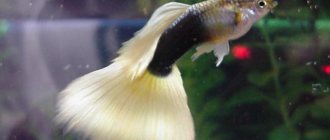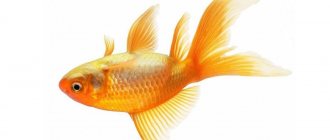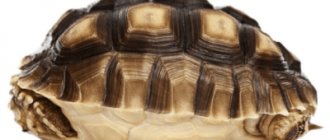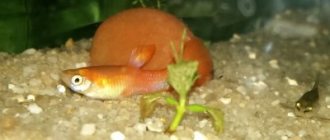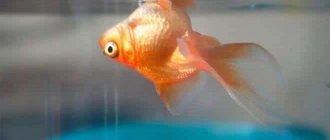Possible reasons
If yesterday the goldfish felt normal, but today they turn over on their backs, swim with their stomachs up, or lie on the bottom of the aquarium, it is very important to establish the root cause of this behavior.
Important! Some aquarists believe that when eating dry food, the fish swallows air, which leads to impaired coordination of movements. But this is an absolutely wrong judgment.
A goldfish lies on the bottom with its belly up.
If a goldfish swims with its belly up, as a rule, the main reason for this condition lies in some kind of disease of a viral, parasitic, or bacterial nature.
Main reasons:
- obesity;
- swim bladder diseases;
- the presence of a foreign body in the gastrointestinal tract;
- oxygen starvation (hypoxia);
- gas embolism;
- congenital pathologies, genetic abnormalities;
- severe stress;
- unbalanced parameters of the aquatic environment;
- infectious, parasitic diseases.
Goldfish are quite voracious creatures, and if you feed them too often, your pet’s metabolic processes are disrupted and simple obesity develops. A similar condition can also be provoked by a monotonous diet, in which food with a high protein content predominates (bloodworms, tubifex). Goldfish are representatives of the order Cyprinidae. They do not have a stomach, so there are no enzymes that break down animal proteins. The main diet of small and adult fish is plant food.
When fish are obese, the liver enlarges, which compresses the swim bladder, which leads to impaired coordination of movements.
Obesity
If the fish has become inactive, hiding in secluded corners of the aquarium, algae or decorative elements, most likely it has suffered severe stress, which can also provoke a violation of swimming functions. Similar behavior can also occur in the first days after placing the fish in the aquarium. As a rule, after an adaptation period, the fish’s condition returns to normal.
Description
The seahorse or Hippocampus is a small ray-finned fish of the pipefish family. Translated from Greek, “hippo” means “horse” and “kampos” means “sea monster”. And in appearance it looks like a knight chess piece.
@Nennieinszweidrei -pixabay.com
This is one of the oldest species of fish, their age is about forty million years. Despite the fact that the skate is a fish, it does not have scales, instead of which a hard bony shell performs protective functions. It is so strong that only a land crab can handle it.
In many species, the shell is protected by a variety of spines, and in some it is also covered with elongated multi-colored processes similar to ribbons, thanks to which the seahorse merges with the algae and becomes invisible to predators.
The sizes of these fish are modest - 10-12 cm. The largest individuals grow up to 30 cm, but this is an exception. There are also very tiny ones - from 3 to 12 mm.
Like its earthly counterpart, the underwater horse has an elongated muzzle, but its eyes are pronounced and large.
The seahorse, like the chameleon, has each eye moving separately from the other, and it can rotate each eye separately in a circle.
@ RicardoParra - pixabay.com
There is another similarity with a chameleon - the ability to change its color. Depending on the situation and the surrounding area, the seahorse adjusts the color of its shell to the color of corals or algae, becoming practically invisible, which allows it to avoid numerous enemies.
Swim Bladder Diseases
If a goldfish swims upside down, on its side, or stays close to the bottom, poor coordination of movement is caused by pathologies and diseases of the swim bladder, which cause a malfunction in its functioning. Loss of buoyancy control may be due to injury, birth defects, gas accumulation in the intestines, or certain diseases (dropsy of Malawi, neoplasms).
Main symptoms:
- the fish swims like a “float”, often floating to the upper layers of water in the aquarium;
- impaired coordination of movements;
- enlarged abdomen;
- rachiocampsis.
Symptoms of swim bladder diseases
In sick fish, while swimming, the caudal fin rises above the level of the head. The fish becomes inactive. Lies on the bottom, floats on its side or tummy up. There may be a decrease or complete absence of appetite.
When the temperature of the aquatic environment decreases, the load on the swim bladder increases due to slower digestion and metabolism in the fish body. Often, compression of the bladder occurs due to an increase in other internal organs. Cysts in the kidneys, fat deposits in the liver, and the inability of females to spawn are common causes of pressure on the swim bladder.
Parasites, viral and bacterial infections can provoke inflammation of the swim bladder, which also leads to disruption of its functioning.
Where does it live?
Seahorses are heat-loving creatures that require warm water with a stable temperature for a comfortable existence, therefore they live mainly in tropical and subtropical seas.
They can most often be found off the coast of Australia, the Philippine Islands, Malaysia and Thailand. There are several species that are found in the Azov and Black Seas.
The majority of seahorses prefer shallow water. Since these fish are sedentary, they are more comfortable near coral reefs and algae, where they can camouflage and hide. They attach their tails to plant stems or corals and “merge” with them.
@katja — pixabay.com
Treatment
If your goldfish swims belly up and all symptoms indicate swim bladder disease, consult a veterinarian or ichthyologist regarding treatment.
First of all, keep the fish on a starvation diet for 2-3 days. On the fourth day, feed your pet boiled and peeled peas.
Warm up the water in the aquarium to 26–27 degrees to make it easier for the fish to reach the upper layers. Lower the water level in the container where the pet is kept.
If the fish is constantly being pushed to the surface, part of its body is exposed to open air, you can add a special conditioner (Stress Coat) to the water, which replaces the secretion of protective mucus on the fish’s body.
If all else fails, treatment is carried out with broad-spectrum antibiotics. The veterinarian will select the dosage and medications.
Foreign bodies
Goldfish love to dig in sand and gravel in search of food, so they often swallow small pebbles. If the fish swims upside down, most likely there is a foreign object stuck in the throat, and if the fish is belly up, it is in the intestines. In this case, you need to catch the sick fish and have it examined. A foreign body from the pharynx can be carefully removed with tweezers.
If the goldfish swims upside down, growths, sores, and white dots are noticeable on the body; if the color changes, we recommend contacting a veterinarian. It is possible that the fish is sick with a parasitic, fungal, or viral disease.
First of all, place the infected fish in a separate container. Some fish diseases are incurable and are characterized by rapid progression and high mortality. Moreover, if you know the characteristic symptoms of the main fish pathologies and start timely treatment, the prognosis in most cases is favorable.
Prevention
To avoid the development of pathologies and diseases, it is necessary to systematically monitor and measure water parameters. The temperature of the water environment should not fall or rise above 23–25 degrees.
Feed your pets high-quality, balanced food. Use dry food that is designed for goldfish. Supplement your diet with herbal supplements. Once a week you can have a fasting day.
Goldfish food
Avoid overfeeding, which can cause obesity. The gravel at the bottom should not be fine. Periodically siphon and clean the bottom of any remaining food. Aeration in the aquarium should be around the clock.
We invite you to join our Zen channel and group on VKontakte or Odnoklassniki, where new articles for pet owners are published.
Similar articles:
- What types of decorations are there for fish?
- Popular fish aquariums
- Dropsy in aquarium fish
Turned white
Color change is a natural phenomenon for goldfish up to 2 years old. As the temperature drops, pets become paler. The color is also influenced by the shade of the primer; white primer leads to a natural lightening of the color. Strange behavior and paleness are caused by diseases and improper maintenance:
Changes in the composition and parameters of the aquatic environment
Very often, ornamental fish sink to the bottom of an artificial reservoir when the acidity level increases and the concentration of salts and mineral components increases. Such sudden changes cause a state of osmotic shock in the fish.
Similar problems can arise when moving new fish to another aquarium or using fertilizers or organic mixtures that are used to feed plant crops. In such cases, it is necessary to purchase a special test and check the water parameters in the aquarium. After this, clean the artificial pond and replace the water in it. It may also be necessary to introduce compounds designed to remove salts and metals from the liquid.
Breed Features
Beginner aquarists should know that for some species of fish, lying on the bottom of an artificial reservoir is completely natural and normal behavior. For example, catfish or corydoras swim all the time in the bottom layers of a reservoir and generally prefer to spend most of the day resting on soft ground.
Neons, fragile and sensitive creatures prone to traumatic injuries, also give preference to the lower layers of the aquarium. For this breed, the bottom of the tank is the most comfortable and safe habitat.
Cichlids, members of the loach family, also spend a lot of time digging in the soil of the aquarium. For them, such behavior is considered a manifestation of the norm in their natural habitat; they also dig up soil and aquatic plants. In addition, by wallowing in stones and soil, these types of aquarium fish cleanse their bodies of mucus, which can provoke the development of dangerous inflammatory processes.
This is explained simply. For a pet, a new aquarium is perceived as another world, unknown and fraught with potential danger. This behavior is especially typical for goldfish, representatives of the labyrinthine, cichlid, carp-toothed, and goldfish families.
Red spots
Causes of red spots:
- Rubella is a collective name for spring viremia of carp, aeromonosis, pseudomonosis and vibriosis - diseases with similar manifestations. Accompanied by hemorrhages, especially in the head area. Other signs: the appearance of ulcers, bulging eyes, swelling of the abdomen. Carry out treatment in a separate container. You will need leukocyte human interferon (1 ampoule per 35 l) in combination with chloramphenicol (2.5 g per 100 l). Apply every other day until the condition improves. Replace a third of the water at least 1-2 times a week. Chloramphenicol (250 mg per 25 g of feed) or furazolidone (0.5 g per 25 g of feed) also helps. Feed the mixture for 6 days. Provide continuous aeration during treatment.
- Skin and gill flukes. Animals behave restlessly, try to scratch themselves on objects, fins are often pressed, red spots appear on the body, and the skin becomes covered with mucus. Treat with special means against parasites or using baths with potassium permanganate.
- Ammonia poisoning.
Tips for fish lovers
The development of many diseases can be avoided if you purchase fish and aquarium components from reliable pet stores. In order to prevent the penetration of parasites into the home pond, new fish should be kept in quarantine for some time. At the same time, you must remember to allocate separate nets and equipment for them.
Under properly organized conditions, guppies rarely get sick. Improved care and compliance with the basic rules for maintaining aquarium inhabitants will be the best prevention of all diseases.
Sources:
https://petshoptop.ru/ru/pet/fishes/health-nutrition/pochemu-ryba-plavaet-nosom-vniz-292 https://aquazoom.ru/disease/disease.php?in=1033 https:// zen.yandex.ru/media/id/595c82e177d0e6f896f7561f/59da40f3256d5ce10206e10e
